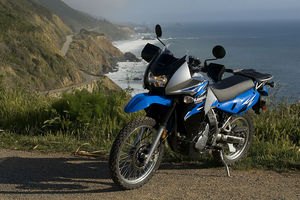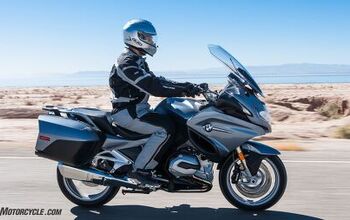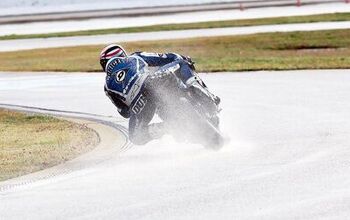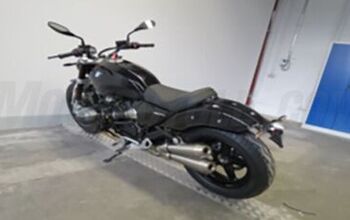Riding With the Wind of Change - Motorcycle.com
"Change is the law of life. And those who look only to the past or present are certain to miss the future."
-John F. Kennedy
This quote has been on my mind lately -- and how fitting that last week I received an email from new MO Editor-in-Chief Kevin Duke inviting me to the press introduction of the newly changed Kawasaki KLR650. My invitation to attend asked that I promptly respond with my availability. It took me 0.03 second to accept.
"I used to own a KLR," I replied. And indeed I did. I logged thousands of miles on my former police-issue KLR, both on pavement and off. I have been on every kind of terrain imaginable with that bike, and because of my past experience on the old KLR, I knew what changes needed to be made.
Kawasaki claims to have made over 50 modifications to the new model KLR650. I didn't think the old model needed 50 changes, but I am not a Kawasaki designer or engineer. My complaints with the old bike were simple: I did not like the suspension, brakes or lack of electricity to power my accessories. I wasn't really crazy about the seat or styling either. That said, the old KLR was one of my favorite bikes simply because of its do-it-all ability -- single track or super highway, it just depends on your mood.
Enter the 2008 KLR650. Kawasaki conducted surveys of KLR owners to determine what changes were desired for the new model. Owners responded that they would like improvements in handling, power, and comfort. In addition to frequent around-town and small trips, 80% of those surveyed claimed to ride their bikes on back roads, and 73% take their KLRs to the trails. Kawasaki's number crunchers determined the growth rate of motorcycling and Adventure Touring in particular to be worth their time to remodel the KLR. I commend Kawasaki for endeavoring to change the KLR. After all, the bike remained basically the same for 20 years and was the fourth-best selling motorcycle for the company. In fact, the KLR650 saw a sales increase of 68% in 2005, a 19% increase in '06 and 15% in '07 even after announcing a new and improved model for 2008.
Ranking first on the list of improvements was handling. The improvements on the '08 were designed to increase the versatility of the already versatile KLR. The spokes on the wheels were upgraded from 3.5mm diameter to 4mm. Up front the 38mm forks were replaced with beefier 41mm legs with stiffer progressive-rate springs. Suspension travel was reduced from 9.1 inches to 7.9 inches which, I know, makes hardcore dual-sporters cringe. Out back is a re-designed Uni-Trak linkage, new progressive shock, swingarm, and reduced suspension travel from 8.1 to 7.3 inches.
I'll admit it; initially I was turned off by the reduction in suspension travel on the new model. Kawasaki claims to have eliminated much of the old bike's static sag, which somewhat reduced overall dynamic travel. The fact is there are situations when some riders will bottom out on either bike. I have bottomed out the old KLR many times while riding the Rocky Mountains. However, with the new suspension's added rigidity, most will never miss the extra travel. I did not give it a second thought while riding the '08 across northern California, both on and off pavement. The bottom line is that the new suspension is a great improvement.
Next on my list of necessities were better brakes. Frankly, the brakes on the old KLR just plain sucked.
No wonder that so many manufacturers came up with replacement brake systems. The new bike comes with a Ninja-inspired 280mm petal-style disc (up from the old 260mm rotor) and twin-piston caliper up front and a petal-style disc with a twin-piston caliper on the rear. Unfortunately, no stainless steel brake lines, but I immediately noticed improved stopping power with no fade under strenuous braking. Our 400-mile ride through twisting California was the perfect testing grounds for the new KLR. Changing the suspension and brakes were the best things that Kawasaki could have done to the new KLR. Ah, but those changes are just the beginning.
Part of the improvement mandate was to make the bike more suited to Adventure Touring. You know, packing as much luggage and electronics on to the bike as possible, then taking it across the country or the world, on and off pavement, then throwing it on the ground a few times, all in the pursuit of adventure while touring. Personally, I'm big on that kind of travel, and the KLR is regarded by many as the standard among adventure-type motorcycles. There are many others that are bigger, faster, and more expensive, but it is difficult to beat the KLR in this segment.
That said, Kawasaki has made many changes to broaden the touring capability of the KLR. All new bodywork, in three colors, with a larger fairing for better wind and elements protection, tops the list. The seat has been replaced (yeah!) with a firmer unit that greatly reduces gluteus-primatis. Vibration transfer to the rider has been reduced with a weighted handlebar and thicker rubber footpegs. A new alternator boosts electrical output from 14.5 to 17 amps to power a new dual-bulb headlight and any electrical accessories. A new luggage rack measures in 90mm longer and 130mm wider. Kawasaki also offers soft luggage, a taller windshield and a gel seat among its factory accessories.
Of all the dramatic changes made to the bike in the interest of improving its touring capability, I can't believe that they did not switch to a six-speed transmission. Yes, the newly tuned engine revs higher and is smoother, but it still buzzed like a horsefly at the Preakness above 80 mph. A six-speed tranny for a calmer highway ride would have been a great change.
Speaking of the engine, Kawasaki's desire to increase the performance and smoothness of the tried and true 651cc Thumper can be categorized as a grocery list of changes.
- Revised cam timing for higher rpm performance.
- New intake ports for better low-end torque.
- New piston rings.
- Throttle-position sensor.
- New one-piece exhaust pipe with smoother bends for increased efficiency.
- New tuning for low- and mid-range grunt.
- New cooling system including lightweight radiator offers a 20% increase in efficiency.
- And last but not least, a new Doohickey.
(All KLR owners know what a Doohickey is, but for those who aren't in the loop, it's a two-piece part called the Idler Shaft Lever that adjusts cam-chain tension, which has been known to fail on old KLRs. Deano tells us that it is the first thing to replace on earlier KLRs because its breakage can cause major engine damage. Kawasaki has upgraded the part to a solid piece for '08. -Ed)
So after leaving it alone for 20 years, the KLR650 has undergone many changes. Some are just a facelift, others are dramatic improvements. So what's it like to ride, you ask? In a word: better.
Well, let me tell you about the ride we took. The press corps was divided into two groups of five with a lead and sweep rider for each group. Our route started in Monterey and traveled south to Cambria for day one; 250-plus miles of spectacular scenery, winding, silky smooth roads, tight, twisty, pock-marked blacktop and double-track dirt.
'The bike feels rock solid and quick up to around 80 mph'
Given the variety of road surface conditions, there was not a better motorcycle for the trip. The new suspension is excellent. The bike felt planted on all surfaces in both cruise and attack modes. The new brakes are another dramatic improvement. I used to consider hard braking on my old KLR a type of Russian roulette; I never knew when or if the brakes would fail (they failed on the White Rim Trail in Moab). Braking is secure and confident on the new KLR.
The frame of the new bike remains unchanged, so there's still a 28.0-degree rake and 4.4 inches of trail. All of the aftermarket bash plates that fit the old KLR will fit the new model. The wheelbase, 58.3 inches, is now 0.6 inch shorter. Riders that prefer to take their motorcycles off pavement have expressed concerns about the lack of suspension travel on the new KLR. Frankly, I prefer the new suspension for the improved handling it provides both on and off pavement. The stock tires are the same Dunlop K750s as the old KLR and are well suited for pavement and lighter off-pavement riding.
The revised engine grunts like an Olympic power lifter in the low range and revs smoothly to 7000 rpm. Kawasaki claims to have increased the power of the new bike, but I didn't notice any significant change in the way the bike accelerates. We were not given any horsepower or torque ratings.
Above 85 the front end feels vague and the engine vibration coaxed me down to about 75 where everything smoothed out. The powerband is well suited to back-road and off-road travel where speeds range from, say, 30 to 65 mph. Don't get me wrong, the '08 KLR can cruise all day at interstate speeds and get about 50 mpg while doing so, I just prefer the ride at a lesser pace.
Day two was 150 or so miles from Cambria back to Monterey via California's coastal Highway 1. It was raining for most of the ride which gave us all an opportunity to test the new bodywork. The larger new fairing does indeed provide substantially better protection. Buffeting was not a problem, but I would like to see the taller accessory windshield as standard. It is a touring bike after all.
'The do-it-all KLR650 has been taken to a higher level'
The new tank shrouds were the hit of the day for me, as they completely protected my legs from the wet. They disguise the fact that it is the same 6.1-gallon tank underneath that has been used on the previous 20 years worth of KLRs. That said, I know from my experience on the old KLR that one can get nearly 300 miles of adventure out of that fuel tank. Thanks to the new bodywork and larger hand guards that kept my hands from getting wet and chilled, I had an enjoyable ride despite the rain.
The new headlight is brighter than the old bike's, but that's not saying much, as my head-mounted, battery-powered camping light is brighter than the old KLR lamp. The new dual headlight provided much better visibility in the rain, which made it much easier for me to keep track of the riders that I led from Cambria to Monterey.
So the winds of change have blown through Kawasaki headquarters. The do-it-all KLR650 has been taken to a higher level. The 50-plus changes have resulted in a much better, more versatile motorcycle. If past performance is a predictor of future results, then the new KLR will do very well for Kawasaki.
At a MSRP of just $5349, the 2008 KLR650 is my first recommendation for someone interested in an adventure-touring motorcycle. Anyone shopping for a versatile explorer would be hard pressed to find a better value than the KLR. A Honda XR650L ($5849) or Suzuki DR650 ($5049) might work better in the dirt, but they can't match the KLR's street prowess. It has all the comfort and versatility of a BMW's F650GS at a cost that's thousands less.
More by Dean Hight & Staff


































Comments
Join the conversation